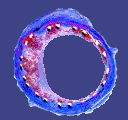FULL PARTNERS

 Harvard-MIT Biomedical Engineering Center.
Harvard-MIT Biomedical Engineering Center.
(1/2/24-31/7/24)
Llavor AUXSTENT "Stents with combined properties of radial and longitudinal growth for pediatric aortic coarctation" with Hardvard-MIT
"Manufacturing of prototypes including production of polymeric tubing and femtssecond laser cutting, Patency related testing, Knowledge transfer and Business plan"
RESUM:
SUMMARY:
Aortic coarctation is a congenital heart defect characterized by a narrow section in the aorta, the main blood vessel that transports oxygenated blood from the heart to the rest of the body. This pathology accounts for 6-8% of all congenital heart defects, with an incidence of approximately 4 per 10,000 births. Untreated aortic coarctation carries a poor prognosis, with a median survival age of 35 years and a mortality of 75% at 46 years. The exact cause of aortic coarctation is not clearly known, but it is thought to be related to developmental problems of the fetus during pregnancy.
Treatment of aortic coarctation may be by surgical repair, transcatheter balloon angioplasty, or transcatheter stent implantation. The appropriate treatment method is determined by factors such as narrow segment morphology, patient age and size, and other comorbidities. Unfortunately, all available treatments present a high risk of short- and long-term complications, including the very frequent need for reintervention, which may affect the future health and survival rate of individuals with aortic coarctation.
Based on the drawbacks of current treatments, the overall aim of this research is to design new polymeric stents that are adapted to the growth needs of children affected by aortic coarctation and that effectively minimize or eradicate new interventions.
The working hypothesis of this project is that stent designs supplemented with materials capable of gradually changing their properties over time (expanding and degrading) will be able to adapt to the arterial changes caused by natural growth and tissue remodeling associated with the treatment of pediatric aortic coarctation. More specifically, the hypothesis is that auxetic designs will outperform metallic implants and keep the arterial lumen open longer due to better integration of the device with the growing aorta.
We will use the money raised with the Llavor grant to manufacture implant prototypes and to run ex vivo proof of concept experiments that demonstrate that such polymeric stents are able to be introduced within an endovascular catheter and expand upon the affected region of a coarcted aorta. This will contribute to the main objective of assessing the patentability and marketability of the novel polymeric auxetic stent to treat pediatric aortic coarctation. Our close contact with industry on the one hand and with our patients on the other makes our team devoted to delivering the best available treatment.
IQS work:
.
IQS news projectes LLAVOR 14/05/2024
BioTech Spain projecte Llavor 15/05/2024
Children's National Innovation District: Winners announced in pediatric medical device competition focused on cardiology - Children's National (childrensnational.org) 15/10/2024
Cardiovascular Business: Pediatric cardiology device competition introduces world to new technologies (cardiovascularbusiness.com) 15/10/2024
Medical Product Outsourcing: Pediatric Medical Device Competition Winners Announced | Medical Product Outsourcing (mpo-mag.com) 15/10/2024
Medical Design & Outsourcing (slideshow of winning devices): Six innovative pediatric cardiology devices win funding (medicaldesignandoutsourcing.com) 15/10/2024
Medical Buyer: Six pediatric cardiology device companies receive $50K grants each – Medical Buyer 15/10/2024
24x7 Magazine: Children's National Names Pediatric Device Competition Winners | 24x7 (24x7mag.com) 15/10/2024
Startup Ticker (Switzerland-based): Generous cash prizes awarded to Swiss startups (startupticker.ch) 15/10/2024
GlobeNewswire: Winners announced in $300,000 pediatric medical device (globenewswire.com) (shared across 80+ online publications) 15/10/2024
Yahoo: Winners announced in $300,000 pediatric medical device competition focused on pediatric cardiology (yahoo.com) 15/10/2024
Tribuna Zamora 8/12/2024
Europapress 4/12/2024
Infosalus 4/12/2024
InfoBAE 4/12/2024
tweetsalud 12/12/2024
Biotech-spain 8/12/2024
Diario Infoperiodistas 18/12/2024
Diariodeciencias 18/12/2024
Cronica de Cantabria 4/12/2024
Diario SigloXXI 4/12/2024
Notimerica 8/12/2024
Diario estrategia 8/12/2024
Publimetro 8/12/2024
20minutos 8/12/2024
Diario de Navarra 8/12/2024
Ara: Investigadors catalans creen un stent pediàtric que s'adapta al creixement dels nadons 8/12/2024
• Francesc Canalejo-Codina; Mariola Cano-Morenilla; Jordi Martorell; Mercedes Balcells; Marta Pegueroles; Andrés A. García-Granada;
“3D printed polymeric stent design: Mechanical testing and computational modeling”
Materials & Design
Volume , October 2024 (Q1 80/438 MATERIALS SCIENCE, MULTIDISCIPLINARY, IF 7.6 y2023)“https://doi.org/10.1016/j.matdes.2024.113395”
For any queries do not hesitate to contact:
Andres-Amador Garcia-Granada:
Via Augusta 390, 08017 Barcelona, Spain
Tel.: +34 932 672 083 / Tel.Cen.: +34 932 672 000 -ext.283
Fax: +34 932 056 266
andres.garcia@iqs.edu
www.iqs.edu

Click here for a complete list of Andres-Amador Garcia-Granada Publications.

 Harvard-MIT Biomedical Engineering Center.
Harvard-MIT Biomedical Engineering Center.
